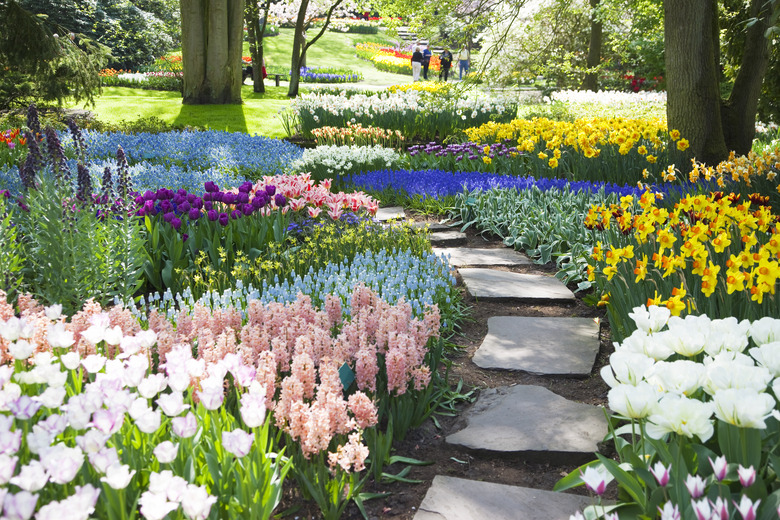Plants For Flagstone Paths
We may receive a commission on purchases made from links.
Flagstone pathways create a rustic and eye-catching route on a property, and they can also withstand years of wear and tear with minimal maintenance. Whether you are trying to create an English cottage look in your backyard, or you simply don't want to have to constantly weed your flagstone pathway, planting in between each stone is the best way to get the job done.
Hundreds of plants are available to fill the gaps between flagstones while adding color and texture to offset the stone, but here are a few favorite plants for flagstone paths.
1. Creeping Herbs for Paths
1. Creeping Herbs for Paths
Herbs are easy to maintain and will release a pleasant scent with every step along your flagstone pathway. What's more cottagecore than walking along your garden path and harvesting some herbs? Roman chamomile and several varieties of thyme, including archer's gold and red creeping thyme (also great for a creeping thyme lawn), prefer dryer conditions and can also be used in food preparation. Another creeping herb, Corsican mint (Mentha requienii), has a mossy rounded form and requires consistent moisture.
2. Grassy Plants for Paths
2. Grassy Plants for Paths
You can, of course, grow lawn grass between your pavers, but be prepared for mowing and maintenance. As an alternative, echo the feeling of a lush lawn by planting miniature rushes, sedges, and other grassy perennials. Make sure to select varieties that keep a tight, low-to-the-ground profile. Eleocharis radicans 'Miniature Rush' hugs the ground and grows well in damp soils. Dwarf mondo grass (Ophiopogon japonicus 'Nana') is not actually a grass and is sometimes referred to as lilyturf. Mondo grass grows well in both sun and shade and is rarely bothered by soil conditions. This tough, clumping plant will slowly spread and grow 3 to 6 inches tall.
3. Moss for Paths
3. Moss for Paths
Mosses are always a favorite for pathways but the soil conditions, moisture needs, and shade requirements must be met for moss to survive. If your flagstones are in the shade, you can grow your own moss by transplanting moss from other areas of the garden and watering regularly until it is established.
If you are planting in a sunnier area, the moss lookalikes Irish and Scotch moss (Sagina subulata) glow a gorgeous Kelly green or bright chartreuse when kept moist and grown in full sun or part shade.
4. Creeping Groundcovers for Paths
4. Creeping Groundcovers for Paths
A flagstone path can be the perfect home for the small leaves of a creeping groundcover—which often provide the extra bonus of pretty blooms. The lime-green hues of creeping Jenny (Lysimachia nummularia) will brighten any garden path in full or part sun, especially when its tiny yellow blooms appear. Carpet bugles like Ajuga reptans 'Mini Crisp Red' and 'Chocolate Chip' have dark plum-colored leaves and grow to around 3 inches in part shade, sending up spikes of blue flowers in late spring. Blue star creeper (Isotoma fluviatilis) will thrive in full or part sun with regular watering and sports pale blue flowers in spring.
5. Sedums and Succulents for Paths
5. Sedums and Succulents for Paths
Succulents can be used to add a rainbow of color and entrancing texture to paths. The cold-hardiest species are stonecrop sedums and hens and chicks (Sempervivum species), which have rounded, spiky, or jagged foliage in reds, greens, blues, and golds that can be mixed and matched. Succulents prefer well-draining soil, making them a great choice for a sandy path washed in sun.
